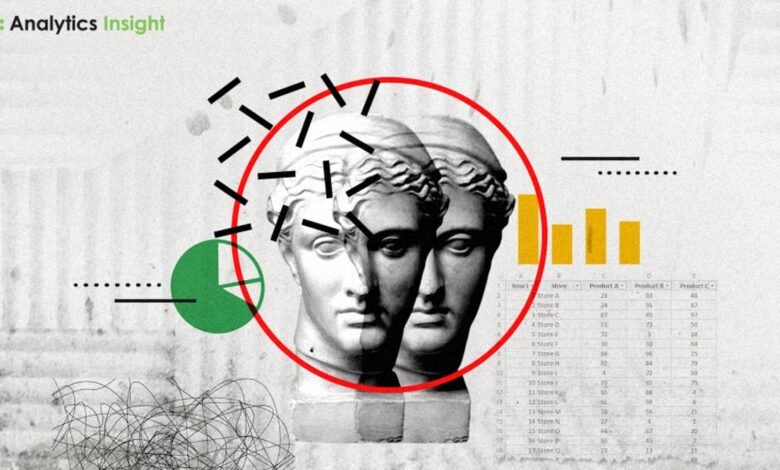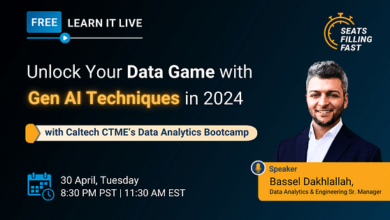Big Data Tools and Technologies: Hands-on Examples & Projects

Big data tools help you organize, store, visualize, and analyze the huge amounts of data that your customers and enterprises generate every day. Big data analytics has a lot of potential, but traditional data tools can’t handle this huge amount of complex data. That’s why several different types of Big Data software and architectural solutions were created.
Big Data Tools pull and analyze data from multiple sources. They can be used for ETL, Data Visualization, Machine Learning, Cloud Computing, and more. With specially designed Big Data tools, you can use your data to discover new opportunities and business models.
Why are big data tools and technologies important to data professionals?
Businesses around the world are beginning to understand the importance of their data. According to Fortune Business Insights, the global market for Big Data analytics is expected to reach $549.3 billion by 2028. Business and IT services will account for half of all revenue by 2028. Many businesses are launching data science initiatives to find new and innovative ways to use their data. As a result, big data tools are becoming increasingly important for businesses and data professionals.
Data engineers create the technology infrastructure that supports big data and big data science projects. A data engineer’s primary job is to design and manage data flows that support analytical initiatives. The challenge is to create a flow that links data from multiple sources to a data warehouse or a shared location. From there, data scientists can use various big Data tools to access the information.
Some Best Big Data Tools and Technologies
1. RapidMiner
RapidMiner is a cross-platform, data science, and predictive analytics application that is used by over 1 million users and by 40,000 companies around the world, including Hitachi, BMW, Samsung, and Airbus. It is available in several licenses, such as small, medium, and large proprietary versions, as well as a free version that supports up to 10000 data rows and 1 logical processor.
RapidMiner has won several awards, including Gartner’s Vision Awards 2021 for Data Science and Machine Learning Platforms, multimodal Predictive Analytics, and Machine Learning Solutions from Forrester, as well as Crowd’s Most User-Friendly Data Science & Machine Learning Platform in the Spring G2 Report 2021.
2. DataRobot
DataRobot Automates, Validates, and Accelerates Predictive Analytics. It Allows Data Scientists and Analysts to Create and Deploy Effective Predictive Models in a fraction of the Time Other Solutions Take. With Over 3.54 billion Models Built and 1000 Years of Combined Data Science Experience on the Customer-Facing Data Science Team. Over a Trillion Predictions for Top Firms Worldwide. Trusted by Customers across Industries, Including a Third of Fortune 50 Companies.
When it comes to Input Data Profiling, Model Creation, and Operational Application Deployment DataRobot Helps Data Scientists & Analysts to Work More Efficiently & Sensibly. It Accelerates the Process of Processing Big Data, Eliminates Time-Suck Activities, and Helps Everyone to Focus on Business Issues Instead of Data Science.
The Most Efficient Open-Source Data Modeling Approaches From R, Python & Spark To H2O & boost & Others.
3. TensorFlow
With over 217,000+ users and 167,000+ stars on Github, TensorFlow is one of the most widely used deep learning frameworks. It is used by big data experts, deep learning researchers, and others to create deep learning algorithms, models, and models. A lot of developers have access to TensorFlow because it is integrated with Python IDEs such as PyCharm. TensorFlow allows engineers to fine-tune their models using tools such as TensorBoard.
TensorFlow is primarily used for running deep neural networks and training computers to learn and make fast decisions. However, businesses also use TensorFlow for partial differential equation (PDE) simulations and recurrent neural networks, as well as NLP (Natural Language Processing) to train machines for interpreting human languages and image recognition, as well as sequence-to-sequence models for machine translation.
4. Apache Spark
Spark is a powerful, open-source big data analytics tool built on top of clustered computing. With over 32k stars on GitHub and 1800 contributors, Spark was designed to handle big data efficiently. It has embedded machine learning algorithms, built-in SQL, and built-in data streaming modules. Spark offers high-level APIs to R, Python, JAVA, and SCA, as well as a wide range of other high-level tools.
Some of Spark’s high-level tools include:
Spark Streaming
MLlib
GraphX
Graph data set processing
Spark SQL
Real-time processing of both structured & unstructured data
Stream vs. Batch real-time processing
Open Source
5. Matillion
Matillion is a leading Enterprise Resource Planning (ERP) and end-to-end (ELT) big data solution for the cloud. With over 650 customers in 40+ countries Matillion is considered among big data tools and technologies, Matillion pulls data from popular sources and loads it into popular cloud data platforms like AWS, Amazon Redshift, and Google BigQuery. It also develops data pipelines to easily integrate your data sources with major cloud data platforms like GCP or AWS. Matillion quickly integrates and transforms your cloud-based data, and provides fast, easy access to your data to maximize its value.
6. Talend
Talend is a widely used open-source Data Integration and Big Data tool that offers a wide range of services to big data professionals. These services include Cloud Services, Enterprise Application Integration, Data Management, and Data Quality.
Talend was one of the first companies to offer a commercially available Data Integration Open-source platform. The company first launched its product in October 2006, and it is now known as the “Talend Open Studio” for Data Integration.
The company has more than 6500 customers around the world. The company offers its products for free open-source licenses. The company’s main product is called the Integration Cloud. It is available in three versions: SaaS, Hybrid, and Elastic. The main features of the Integration Cloud are:
Broad connection
Integrated data quality
Native code generation
Integrated big data tools
Few Big Data Projects Idea
Amazon Web Services (AWS) Glue
Amazon Web Services (AWS) Glue is a data integration service that is serverless and scalable. It helps you access, process, move, and combine data from multiple sources to analyze, machine learn, and develop applications. AWS Glue works with other big data tools as well as AWS services to streamline your end-to-end (ETL) workflows, build data lakes or warehouses, and streamline output streams. It uses API operations to change your data, generates runtime logs, and generates notifications to help you keep track of the performance of your jobs. With AWS Glue, you can focus on developing and tracking your ETL operations because it combines these services into one managed application.
Amazon Redshift
Redshift is a cloud-based data warehouse service that enables you to use your data to get new insights about your customers and your business.
Redshift Serverless allows you to import and query your data in the Redshift data warehouse to get new insights from your data.
Redshift is an easy-to-use big data tool that allows engineers to create Schema and Tables, load your data visually, analyze database objects, and more.
Redshift supports more than 10,000 clients and offers unique features and powerful data analytics tools.
Some of the biggest names in data science include:
The Walt Disney Company
Koch Industries Inc.
LTK
Amgen
More
Some Project Examples
Medical Insurance Fraud Detection
A cutting-edge data science model that utilizes real-time analytics and classification algorithms to help identify and prevent medical insurance fraud. This tool can be used by the government to help improve patient, pharmacy, and doctor confidence, reduce healthcare costs, and reduce the effects of medical services fraud. Medical services fraud is a major issue that costs Medicare, Medicaid, and the insurance industry a great deal of money. Four large datasets have been combined to create a single table for the final data analysis. These datasets include Part D prescriber services, which include information such as the name of the doctor, address of the doctor, illness, symptoms, etc. Additionally, a list of excluded individuals and entities (LEIE) is included, which is a list of individuals and substances that are not allowed to participate in governmentally funded social insurance programs (e.g. Medicare) due to past medicinal service extortion. Finally, payments received by physicians from pharmaceuticals are also included.
The CMS part D dataset is a collection of data from the Centers for Medicare and Medicaid Services (CMS). This dataset has been created by combining different key features with different Machine Learning (ML) algorithms to see which one works best. The ML algorithms have been trained to identify any anomalies in the dataset so the authorities can be made aware of them.
Text-Mining Project
This text-mining project will require you to analyze and visualize the text of the delivered documents. This is a great deep-learning project idea for beginners. The demand for text mining is high, and it will help you to showcase your skills as a data scientist in this project. You can use Natural Language Process Techniques (NLP) to gather some valuable information from the link below. The link provides a list of NLP tools & resources for different languages.
Disease Prediction Based on Symptoms
The rapid development of technology and data has made the healthcare domain one of the most important areas of study in the modern era. The vast amount of patient data can be difficult to handle. Big Data Analytics facilitates the management of this information. Electronic Health Records (EHRs) are one of the largest examples of the use of big data in the healthcare sector. The knowledge gained from big data analysis provides healthcare specialists with insights that were previously unknown.
In the healthcare sector, big data is utilized at every step of the process. Medical research, patient experience, and outcomes are all supported by big data. There are many ways to treat various ailments around the world. Machine learning and Big Data are two new approaches that help in the prediction and diagnosis of diseases.
How can machine learning algorithms predict diseases based on symptoms?
The following algorithms have been studied in code:
Naive Bayes
Decision Tree
Random Forest
Gradient Boosting
In conclusion, big data tools will help to organize, store, visualize, and analyze the vast amounts of data that your customers and businesses generate every day. Big data analytics has a lot of potential. We have listed a few big data tools and technologies with relevant examples that can help you deal with these tools and gain hands-on experience; though there are many sets of tools to explore out there.



